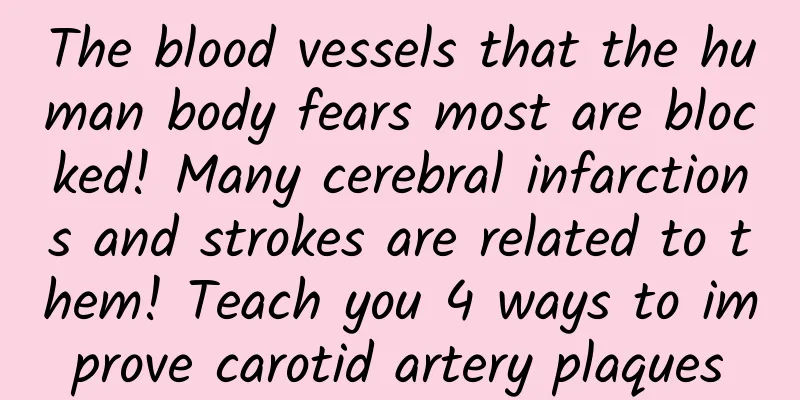The blood vessels that the human body fears most are blocked! Many cerebral infarctions and strokes are related to them! Teach you 4 ways to improve carotid artery plaques

|
Carotid artery, the blood vessel that the human body is most afraid of being blocked Our blood vessels are like water pipes The longer you use The more garbage is deposited Over time, blood vessels develop plaques. If you have high blood pressure, high blood lipids, or high blood sugar And not paying attention to lifestyle and eating habits Plaques may grow larger Like a "time bomb" lurking in the body The carotid artery is called the "window" for monitoring blood vessels throughout the body . Let's first look at where the carotid artery is. If you touch the sides of your neck with your hands, you can feel two blood vessels "beating" vigorously. These two blood vessels are the carotid arteries, through which all the blood in the body flows. Image source: Photo Network Carotid artery plaque is a focal lesion structure under the arterial intima. Once it appears, it may indicate that blood vessels throughout the body are gradually hardening, and the risk of cardiovascular and cerebrovascular diseases will also increase . A study published in a Lancet journal evaluated the prevalence, number of patients and risk factors of carotid atherosclerosis in people from 21 countries and regions around the world. The results showed that nearly 2 billion people worldwide had carotid atherosclerosis in 2020. Among people over 40 years old in China, the detection rate of carotid plaques exceeded 40% . Risk factors for carotid artery plaques include uncontrollable risk factors such as age, gender, race, and genetic factors . As well as controllable risk factors such as smoking, hypertension, diabetes, and hyperlipidemia . In the physical examination reports of some middle-aged and elderly people, it is easy to see words such as "carotid artery plaque formation" and "carotid intima-media thickening". So, if a physical examination reveals carotid artery plaques, is it necessary to take medication to treat it? In fact, not all carotid artery plaques require medication . According to the "Chinese Consensus on Diagnosis and Treatment of Head and Neck Atherosclerosis 2017", doctors need to consider the overall cardiovascular risk before deciding whether to use drug treatment for the patient. However, once carotid artery plaques are detected, it is still recommended that everyone adjust their lifestyle, minimize bad habits, and control risk factors for cardiovascular and cerebrovascular diseases, such as controlling high blood pressure, diabetes, dyslipidemia, quitting smoking and limiting alcohol consumption. By changing your lifestyle, adjusting your diet, and taking appropriate medication under the guidance of a doctor, some carotid artery plaques can be reversed, shrunk, or even disappear. 1 Lifestyle interventions Combine aerobic and resistance exercise, at least 150 minutes per week of moderate-intensity activity, or at least 75 minutes per week of vigorous-intensity aerobic activity, or an equal combination of the two intensity activities; Image source: Photo Network In addition, there are also low-salt and low-fat diets, weight control, smoking cessation and alcohol restriction, and maintaining mental health. Image source: Photo Network 2 Controlling risk factors Actively control risk factors such as hypertension and diabetes: • In general, the blood pressure of hypertensive patients should be reduced to below 140/90 mmHg; for those who can tolerate and some high-risk patients, the blood pressure can be further reduced to below 130/80 mmHg; for patients over 80 years old, the blood pressure should be controlled below 150/80 mmHg. • The HbA1c target for most patients with type 1 or type 2 diabetes is < 7.0%; the blood sugar standard should be appropriately relaxed for the elderly and frail. • Control blood lipids. 3 Drug treatment Statins: Statins reduce cholesterol synthesis and have anti-inflammatory effects that are independent of lowering cholesterol levels. Antiplatelet drugs: For example, enteric-coated aspirin tablets have anti-inflammatory, antioxidant, endothelial cell protection, smooth muscle proliferation inhibition, plaque stabilization, and anti-platelet aggregation effects. Attention! Drug treatment must be carried out under the guidance of a professional physician. 4 Surgery For patients who have recently suffered a transient ischemic attack (TIA) or an ischemic stroke within 6 months and have moderate to severe stenosis of the ipsilateral extracranial carotid artery, carotid endarterectomy (CEA) or carotid artery stenting (CAS) is recommended. Surgical treatment is not recommended for mild stenosis. If you don’t want to get plaques, keep the following in mind Maintain a healthy lifestyle: Proper diet, smoking cessation and alcohol restriction Regular exercise and good sleep Control weight, blood pressure, blood sugar, and blood lipids Regular physical examinations for high-risk groups to detect the disease early Statement: This article is a medical-related educational popular science article. It does not involve specific treatment methods or medical behaviors and cannot replace hospital visits. Experts who reviewed this article References [1]SCHLOSSER RJTNEJO M. Clinical practice. Epistaxis [J]. 2009, 360(8): 784-9. [2]MULLA O, PROWSE S, SANDERS T, et al. Epistaxis [J]. 2012, 344: e1097. [3]PATEL RJFPS F. Nasal Anatomy and Function [J]. 2017, 33(1): 3-8. [4]VALLAMKONDU V, CARLILE S, SHAKEEL M, et al. Neck abscess and vocal cord paresis: delayed complications of a self-extruded long fishbone stuck in throat [J]. 2013, 2013. [5]ESPARAZ J, CARTER S, MATHIS M, et al. Esophageal Foreign Body Management in Children: Can It Wait? [J]. 2020, 30(12): 1286-8. [6]STUBINGTON T, KAMANI T. Food bolus and oesophageal foreign body: a summary of the evidence and proposed management process [J]. 2021. [7]ACHESON A, SCHOLEFIELD JJ B. Management of haemorrhoids [J]. 2008, 336(7640): 380-3. [8]NISAR P, SCHOLEFIELD JJ B. Managing haemorrhoids [J]. 2003, 327(7419): 847-51. [9]SANDLER R, PEERY AJCG, ASSOCIATION HTOCPJOTA G. Rethinking What We Know About Hemorrhoids [J]. 2019, 17(1): 8-15. [10] Chen Xiaoping, Wang Jianping. Surgery. 8th edition[M]. Surgery. 8th edition, 2013. Content Production Edit: 100% sweet Map: Eastern Zhou Dynasty |
<<: Dark matter vs. modified gravity theory, has the ultimate showdown begun?
>>: These two male humpback whales, what are you doing | Nature Trumpet
Recommend
Is our love of drinking determined by our genes?
Leviathan Press: Both the United States and the S...
Volkswagen extends 21 billion euro credit loan due to cheating scandal
According to Reuters, Volkswagen Group said on No...
"18 Psychological Manipulation Techniques for Marriage and Love" conquers men's weaknesses and firmly locks their hearts
Training course content: Women are always trapped...
Dual-engine drive to analyze JD.com's ambition to become an international smart company
"Don't miss out on the Chinese market wi...
Why is it so hot this year?
Mixed Knowledge Specially designed to cure confus...
Woolen sweaters shrink when washed, so will woolen sweaters shrink when they take a bath?
There are a wide variety of wool sweaters on the ...
4 steps to execute and implement event operations
How to execute and implement a complex and large-...
From Kuaishou mini games to multi-platform and multi-format monetization, the road to multi-platform monetization of small animation videos
From Kuaishou mini games to multi-platform and mu...
Why has Nissan's steer-by-wire technology, which it recalled ten years ago, suddenly become popular in China?
Steer-by-wire, which has not been mentioned for a...
Is it a waste to eat the whole enoki mushrooms?
The third installment of 8 little-known facts is ...
Who understands! It turns out that the whole world is pretending to be "adults"
After the Chinese New Year, in the eyes of your p...
Review | How did Douyin, which has been online for 500 days, compete with Kuaishou and Meipai?
The product was meticulously polished for 200 day...
How should the boss spend 10 million? Mainstream promotion channel combination strategy
From this article, you can learn about the mainst...
2019 Pinduoduo user operation analysis!
This paper mainly analyzes the basic attributes, ...
What are the functions of the Guangzhou WeChat blind date mini program? How much does it cost to make a matchmaking app?
Nowadays, the ratio of men to women is unbalanced...









